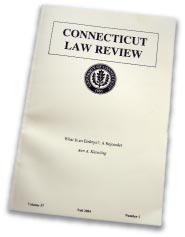Connecticut Law Review
 A Call To Action For Scientists
A Call To Action For Scientists
The burden now falls to scientists to inform law makers and the public about new technologies and the new terminology needed to describe them accurately.
“What Is An Embryo?” is the first comprehensive look at the influence of accurate science terminology, published by the Connecticut Law Review along with rejoinders by Dr. Harold Shapiro, Prof John A. Robertson, Prof Lars Noah, and Father Kevin P. Quinn. The law review specifically addresses the controversy of all of the entities that are currently called embryos with regards to embryonic stem cell research legislation around the world. (download brochure (pdf))
“Ann Kiessling’s thoughtful and extremely useful review covers a good deal of history, language, and public policy intimately related to the controversial technologies that surround the use of embryos either in biomedical research or ART.”
– Excerpt, page 1049, “What is an Embryo? A Comment” by Harold T. Shapiro, Emeritus, Princeton University
“No one would deny that the subtleties of human embryology are neglected in public debate. This alone should compel scientists to choose terms that make scientific sense and to provide clear definitions. Dr. Kiessling has accepted well that challenge. But I also think that Kiessling is up to something else in her essay. She is attempting to reposition science, to gain for it a more influential voice in the heated politics of embryonic discourse.”
– Excerpt, page 1163, “The Politics of Embryonic Discourse” by Kevin P. Quinn, S. J. Professor of Law, Georgetown University Law Center
 I. INTRODUCTION AND DEFINITION OF THE PROBLEM
I. INTRODUCTION AND DEFINITION OF THE PROBLEM
“Most scientific and medical discoveries are accompanied by new terms to describe the new processes. Although this imposes the burden on society of continually learning a new lexicon, new terminology clarifies that the societal impact of emerging technologies needs to be newly interpreted.”
– Excerpt, page 1, Ann A. Kiessling, PhD
“As stated in the Commentary, the goal was not to try to re-define existing moral and ethical views of tasks undertaken by eggs, especially ‘when life begins’ but to try to make room in those views for the emerging biomedical technologies that are currently dependent upon the innate capabilities of human eggs.”
– Excerpt, page 2, “Rejoinder,” Ann A. Kiessling, PhD
Available for order from William S. Hein & Co., Inc.
www.wshein.com | (800) 828-7571 or download free at this link: What Is an Embryo?
Read the rejoinder: What is an Embryo?: A Rejoinder
